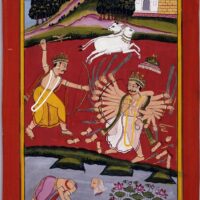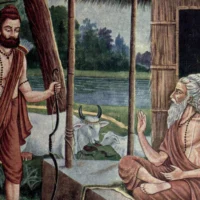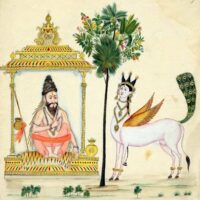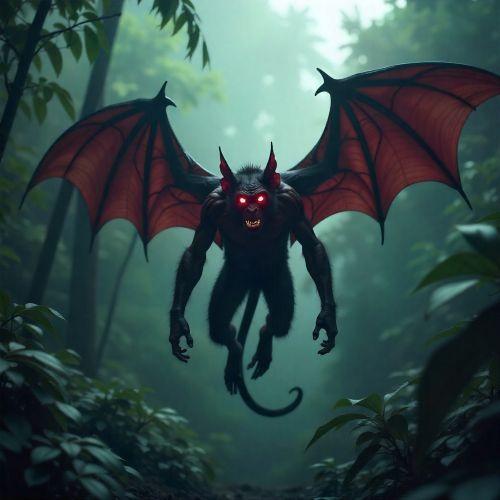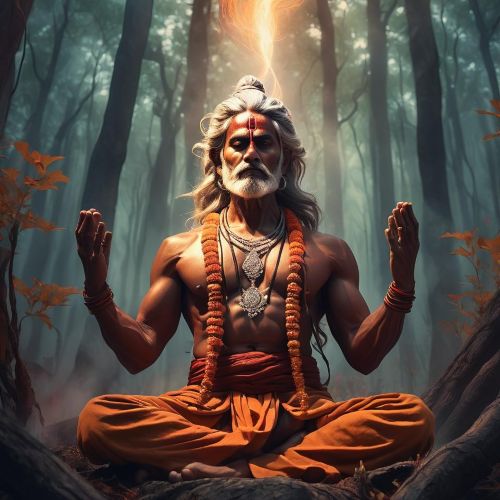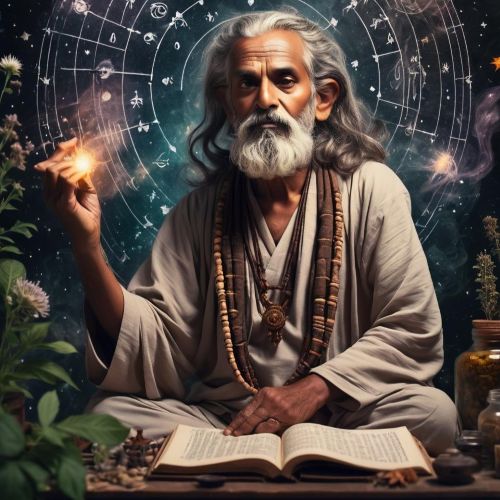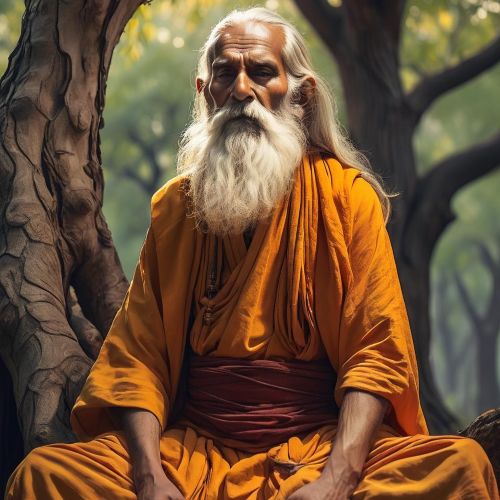Jamadagni : The Fiery Sage
Listen
At a glance
| Description | |
|---|---|
| Origin | Indian Mythology |
| Classification | Gods |
| Family Members | Richika (Father), Satyavati (Father), Renuka (Wife), Ṛumaṇvān, Suhotra, Vasu, Viśvāvasu, Parashurama (Sons) |
| Region | India |
| Associated With | Fire, Charity |
Jamadgini
Introduction
Jamadagni (Sanskrit: जमदग्नि), whose name translates to “consuming fire” or “great fire,” is one of the most influential sages in Hindu mythology. He belongs to the Bhargava lineage of the sage Bhrigu and is remembered both for his immense spiritual wisdom and his intense temper. His role as the father of Parashurama, the sixth avatar of Vishnu, further elevates his place in Hindu tradition. Narratives surrounding Jamadagni emphasize themes of discipline, sacrifice, and the consequences of unchecked anger. From his possession of the divine cow Kamadhenu to his tragic death at the hands of King Kartavirya Arjuna’s sons, Jamadagni’s story is woven into some of the most defining mythological events of the Puranic age. His life represents the complex interplay of ascetic values, dharmic responsibility, and human frailty.
Physical Traits
Ancient scriptures seldom describe Jamadagni’s appearance in detail, as emphasis in Vedic and Puranic literature often rests on the spiritual character of sages rather than their physical form. However, symbolic portrayals present him as an austere figure with matted hair, dressed in simple bark garments or deer skin, embodying the life of a strict ascetic. His fiery aura, implied in the meaning of his name, reflects his volatile temper and uncompromising nature. Artists and temple iconography sometimes depict him seated in meditation, with a stern gaze that conveys both wisdom and severity. This symbolic representation reinforces the idea that Jamadagni’s true “form” was defined not by outward features but by the intensity of his inner fire and spiritual energy.
Family
The lineage of Jamadagni is central to his story and connects him to multiple dynasties within Hindu mythology. He was born to Sage Richika and Princess Satyavati, the daughter of King Gaadhi. His birth itself is marked by a ritual mishap: Richika prepared consecrated offerings meant to bestow Brahminic qualities upon his son and warrior-like traits upon Satyavati’s brother, but through an accidental exchange, the destinies of their offspring were reversed. Thus, Jamadagni was born with both the fiery temperament of a Kshatriya and the wisdom of a Brahmin.
Jamadagni married Renuka, a princess famed for her devotion and chastity. Together they had five sons—Rumaṇvān, Suhotra, Vasu, Viśvāvasu, and Rama Bhargava, who would later be recognized as Parashurama, one of Vishnu’s most powerful incarnations. The family’s story is not without tragedy. In one of the most dramatic episodes, Jamadagni, suspecting Renuka’s purity after she was momentarily distracted in thought, ordered his sons to execute her. Only Parashurama obeyed, beheading his mother at his father’s command. Pleased with his obedience, Jamadagni offered Parashurama a boon, and he immediately requested the restoration of his mother and forgiveness for his brothers. This episode, though unsettling, highlights the tension between duty and compassion that runs through Jamadagni’s life.
His death was equally dramatic. When Kartavirya Arjuna, the mighty king endowed with a thousand arms, learned of Jamadagni’s possession of the divine cow Kamadhenu, he attempted to seize it by force. Though initially unsuccessful, Kartavirya’s sons later attacked Jamadagni’s hermitage in his absence and killed the sage mercilessly. This brutal act set the stage for Parashurama’s legendary campaign of vengeance, during which he annihilated the Kshatriya clans twenty-one times, reshaping the balance of power between warriors and Brahmins in mythic history.
Other names
Jamadagni appears under multiple titles and epithets across different scriptures, reflecting the reverence accorded to him. In the Mahabharata and Puranas, he is often referred to as Bhargava or Bhargavanandana, highlighting his descent from the sage Bhrigu. He is also addressed as Ṛcīkaputra, meaning “son of Richika,” and Bhṛguśreṣṭha, the foremost among the Bhargavas. Some texts call him Rama Jamadagnya, connecting him directly to his most famous son. His name itself—derived from “jamad” (to consume) and “agni” (fire)—symbolizes his fiery temperament and his association with spiritual purification. These diverse names underscore his importance in both genealogical and theological contexts, situating him firmly within the vast fabric of Hindu tradition.
Powers and Abilities
Jamadagni was renowned for his mastery of both spiritual and martial disciplines. He was deeply versed in the Vedas and Puranas, capable of invoking powerful mantras and performing intricate rituals. His penance and meditation gave him a fiery spiritual presence that could not be ignored. One of his most celebrated possessions was Kamadhenu, the wish-fulfilling cow that could provide endless resources. This divine gift, granted to him by the gods, symbolized abundance and was a source of both blessing and conflict.
In addition to his ascetic and ritualistic prowess, Jamadagni also possessed significant knowledge of weaponry. Some traditions credit him with teaching Parashurama the science of warfare, ensuring that his son was prepared to fulfill his destiny. His temper, however, was as legendary as his wisdom. When provoked, Jamadagni’s anger could manifest as curses or fiery retribution, reminding even kings of the consequences of arrogance. In some accounts, his mystical abilities even extended to reviving the dead through ritual, as seen in the episode where Renuka was restored to life after being slain. These powers collectively highlight his dual identity as both sage and wielder of divine authority.
Modern Day Influence
Though Jamadagni lived in the age of myth, his legacy continues to resonate in modern India. He is venerated in several temples, particularly in regions like Himachal Pradesh and Kerala, where local traditions associate him with spiritual strength and moral authority. His presence in the cultural landscape is often tied to the worship of Parashurama, who remains a central figure in folklore and ritual practices.
Jamadagni’s story is frequently cited in discussions of dharma, especially the tension between parental authority and filial duty. The episode of Renuka’s beheading is interpreted in various ways—some view it as a symbol of absolute obedience, while others see it as a cautionary tale about the dangers of excessive rigidity. His tragic death and the resulting cycle of vengeance are also referenced in philosophical discourses on violence, justice, and the karmic cycle.
In contemporary contexts, Jamadagni’s name has been adopted by organizations, cultural groups, and even trekking associations, reflecting the enduring strength of his identity as a symbol of resilience and fiery determination. His life is regularly retold in modern literature, television adaptations of epics, and regional folklore performances. Even today, his figure serves as a reminder of the delicate balance between spiritual wisdom and human emotion, a theme that remains deeply relevant in philosophical and cultural debates.
Related Images
Source
Wikipedia contributors. (2024). Jamadagni. Wikipedia. Retrieved September 11, 2025, from https://en.wikipedia.org/wiki/Jamadagni
Faron, A. (2024, November 29). The Life of Sage Jamadagni: The Warrior Sage. Hindu Mythology Worldwide. Retrieved September 11, 2025, from https://hindu.mythologyworldwide.com/the-life-of-sage-jamadagni-the-warrior-sage/
Acharya Ganesh. (2024, November 8). Sage Jamadagni: The Father of Parashurama in Hindu Mythology. AcharyaGanesh.com. Retrieved September 11, 2025, from https://acharyaganesh.com/rishis/jamadagni
Story of Jamadagni. (2019). https://www.wisdomlib.org/hinduism/compilation/puranic-encyclopaedia/d/doc241636.html
Indian Mythology: Sage Jamadagni. (2021). https://discover.hubpages.com/literature/Indian-Mythology-Sage-Jamadagni
Jamadagni – Gotras. (n.d.). https://gotras.com/jamadagni/
Frequently Asked Questions
What is lorem Ipsum?
I am text block. Click edit button to change this text. Lorem ipsum dolor sit amet, consectetur adipiscing elit. Ut elit tellus, luctus nec ullamcorper mattis, pulvinar dapibus leo.
What is lorem Ipsum?
I am text block. Click edit button to change this text. Lorem ipsum dolor sit amet, consectetur adipiscing elit. Ut elit tellus, luctus nec ullamcorper mattis, pulvinar dapibus leo.
What is lorem Ipsum?
I am text block. Click edit button to change this text. Lorem ipsum dolor sit amet, consectetur adipiscing elit. Ut elit tellus, luctus nec ullamcorper mattis, pulvinar dapibus leo.
What is lorem Ipsum?
I am text block. Click edit button to change this text. Lorem ipsum dolor sit amet, consectetur adipiscing elit. Ut elit tellus, luctus nec ullamcorper mattis, pulvinar dapibus leo.
What is lorem Ipsum?
I am text block. Click edit button to change this text. Lorem ipsum dolor sit amet, consectetur adipiscing elit. Ut elit tellus, luctus nec ullamcorper mattis, pulvinar dapibus leo.


